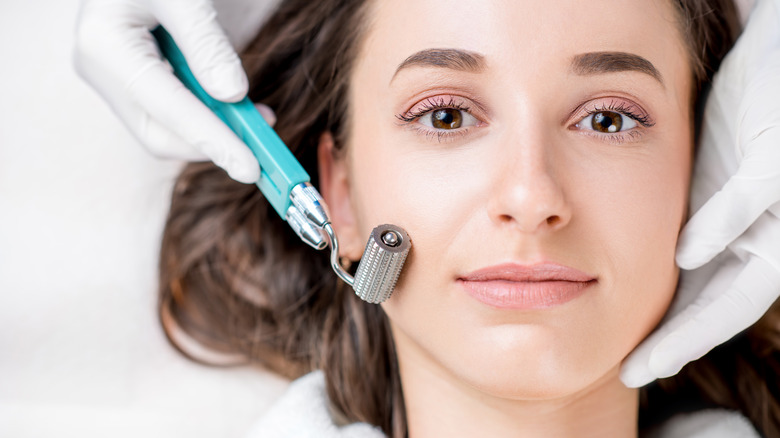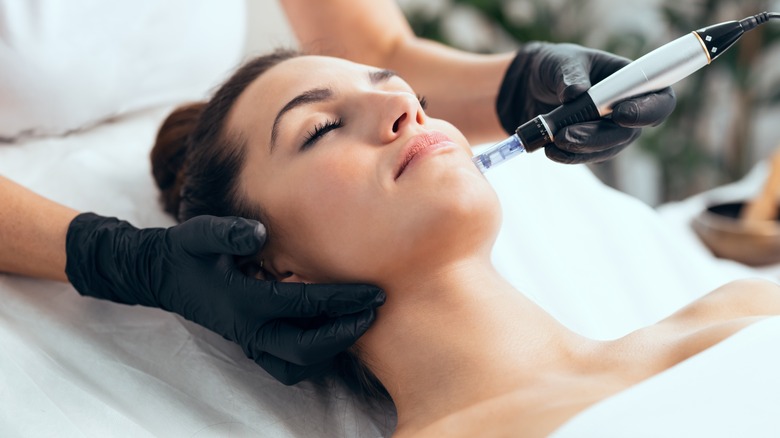Microneedling Vs Chemical Peel: Which Is The Better Treatment For You?
The rise of non-surgical beauty treatments, like microneedling and chemical peels, has made it possible for people to achieve subtle, natural-looking results without the need for surgery. This has made cosmetic procedures more appealing to a wider range of people, including those who may have been hesitant to undergo surgery in the past. No doubt, an increasing number of people are more concerned about maintaining their appearance and youthfulness as they age. The advances in technology and medical techniques have made cosmetic procedures safer and more effective, per a 2012 article published in the Canadian Journal of Plastic Surgery.
As cosmetic procedures become more affordable and accessible, people can seek treatments to improve their appearance. Social media, television, and the internet have made it easier for people to learn about different cosmetic procedures and see the results that others have achieved. However, with the huge variety of procedures, confusion can arise regarding the differences between them. For example, microneedling and chemical peels are both cosmetic procedures that can improve the appearance of the skin, but they work in different ways.
What is microneedling?
Microneedling is a cosmetic procedure where a device with fine needles creates tiny punctures in the skin. The procedure helps heal the skin while stimulating the production of collagen and elastin — proteins that give skin its structure and elasticity, per the Cleveland Clinic. Microneedling is used to treat a variety of skin concerns, such as fine lines and wrinkles, acne scars, and large pores, per the clinic. It is also used to improve the overall appearance of the skin.
The procedure begins by cleaning the skin and applying a numbing cream to minimize discomfort. The microneedling device is then passed over the skin, creating small punctures. The depth and spacing of the punctures can be adjusted depending on the area being treated and the desired outcome, says the Cleveland Clinic. After the procedure, the skin may be red and swollen, but these side effects usually resolve within a few days. Your skin may also be a little sensitive to the sun, so it is recommended to avoid sun exposure and to use sunscreen, per Healthline.
Microneedling can be done in a single treatment or in a series of treatments, depending on the desired outcome and the severity of the skin concern. It's important to note that results may not be immediately visible, and you might need multiple treatments to achieve the desired results.
What is a chemical peel?
According to the Mayo Clinic, a chemical peel is a cosmetic procedure that uses a chemical solution to remove the broken and old skin on the outer layers. The solution causes the skin to peel off, revealing a new layer of skin that is smoother and less wrinkled. Chemical peels are used to improve the appearance of the skin, treating issues such as fine lines, wrinkles, acne, age spots, and uneven skin tone, per the clinic.
There are different types of chemical peels, each with varying strengths and formulations. They are classified into three categories: superficial, medium, and deep peels, per Healthline. Light peels, also called superficial peels, use mild acids, such as alpha-hydroxy acids (AHAs), to exfoliate the skin and are considered the mildest form of chemical peel. Medium peels involve more powerful acids, like trichloroacetic acid (TCA), that reach the skin's deeper layers. They are used to treat more severe cases of damaged skin cells. Deep peels also use trichloroacetic acid to penetrate the deepest layers of the skin. The procedure normally begins by cleaning the skin. Then the chemical solution is applied to the skin. An anesthetic is sometimes administered to people undertaking the deep peel procedure.
Which of the two treatments is best for me?
Both microneedling and chemical peels have unique benefits, and the best treatment for you depends on your skin concerns and goals. It's important to consult with a dermatologist before undertaking any treatment. According to Wall Street Dermatology, microneedling might be a more aggressive procedure. In terms of results, microneedling offers fewer risks than chemical peels and can improve the overall appearance of the skin as well as treat fine lines, wrinkles, acne scars, and large pores, says the clinic. This claim is reiterated by this 2022 study published in the Journal of Clinical and Aesthetic Dermatology. According to the study, microneedling had better results for the treatment of acne scars. However, dermatologists do warn that at-home microneedling and chemical peels are too risky. It's safer and more hygienic to leave these procedures to the experts.
Both microneedling and chemical peels effectively improve the skin's appearance. However, if you're after a more aggressive treatment, microneedling might offer better results — chemical peels generally work best for surface-level issues.



